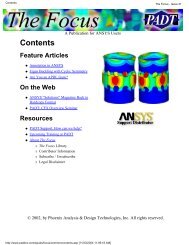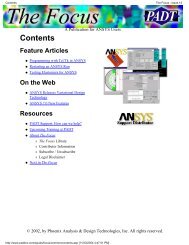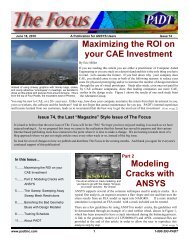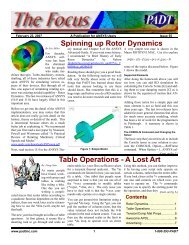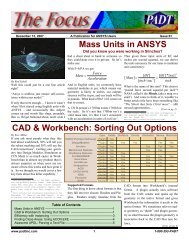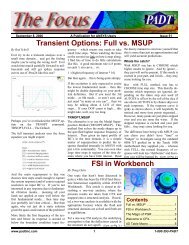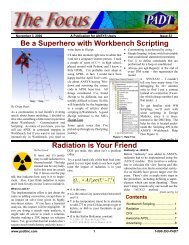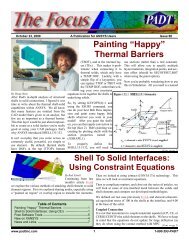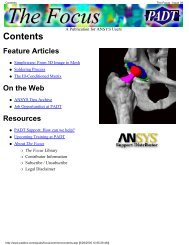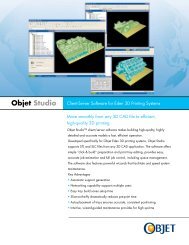The Focus - Issue 16 - PADT
The Focus - Issue 16 - PADT
The Focus - Issue 16 - PADT
You also want an ePaper? Increase the reach of your titles
YUMPU automatically turns print PDFs into web optimized ePapers that Google loves.
Contents<br />
<strong>The</strong> <strong>Focus</strong> - <strong>Issue</strong> <strong>16</strong><br />
Contents<br />
A Publication for ANSYS Users<br />
Feature Articles<br />
●<br />
●<br />
●<br />
SigFit: New optics connection improves ANSYS’s<br />
vision<br />
ANSYS Inc. Buys Microsoft!: A special April 1st<br />
report<br />
Archiving Models<br />
On the Web<br />
●<br />
ANSYS Non-Linear Capability Paper [PDF]<br />
Resources<br />
●<br />
●<br />
●<br />
<strong>PADT</strong> Support: How can we help?<br />
Upcoming Training at <strong>PADT</strong><br />
About <strong>The</strong> <strong>Focus</strong><br />
❍<br />
❍<br />
❍<br />
❍<br />
<strong>The</strong> <strong>Focus</strong> Library<br />
Contributor Information<br />
Subscribe / Unsubscribe<br />
Legal Disclaimer<br />
© 2002, by Phoenix Analysis & Design Technologies, Inc. All rights reserved.<br />
http://www.padtinc.com/epubs/focus/common/contents.asp [11/23/2004 3:58:06 PM]
SigFit: New optics connection improves ANSYSs vision<br />
<strong>The</strong> <strong>Focus</strong> - <strong>Issue</strong> <strong>16</strong><br />
SigFit New Optics Connection<br />
Improves ANSYSs Vision<br />
by Eric Miller<br />
<strong>The</strong> Cool Add-ons for ANSYS Series<br />
<strong>The</strong> other day, a user mentioned a specific feature that ANSYS did not contain. In<br />
looking for a solution, I noticed that there are a lot of cool little programs out<br />
there that people are selling that dont get a lot of press. So, since Rod is always<br />
e-mailing me about new articles, it seemed <strong>The</strong> <strong>Focus</strong> would be a good place to<br />
highlight a few. <strong>The</strong> first one is a nifty tool for the optics world. Truth is, the last<br />
time I even vaguely understood this sort of thing was when I dated an optometry<br />
student in college and a hot date consisted of helping her cram for finals... but I<br />
digress. Since we have a couple of users who do telescopes and fiber optics, it<br />
seemed like a good place to start.<br />
SigFit<br />
can use.<br />
A Publication for ANSYS Users<br />
ANSYS users who work in the world of optics now<br />
have a new way to talk to their optical simulation<br />
tools. Sigmadyne, a consulting company in upstate<br />
New York, has a tool called SIGFIT that now<br />
interfaces between ANSYS and CODE-5 or ZEMAX.<br />
<strong>The</strong> program allows you to perform sequential<br />
mechanical-optical solutions by converting deformed<br />
ANSYS geometry into information the optics codes<br />
<strong>The</strong> current version supports Zernike Polynomial fitting, Adaptive Optics<br />
(actuator controlled) and Harmonic/Random/Transient dynamic analysis under an<br />
easy to use Graphical User Interface. <strong>The</strong> plan for sometime this year is to add<br />
thermal effects and stress birefringence.<br />
If you work with optics, please visit the Sigmadyne web site. At $3,000 per year<br />
this looks like something that can save a lot of time. Contact them for more<br />
http://www.padtinc.com/epubs/focus/2003/00<strong>16</strong>_0401/article1.htm (1 of 3) [11/23/2004 3:58:37 PM]
SigFit: New optics connection improves ANSYSs vision<br />
<strong>The</strong> <strong>Focus</strong> - <strong>Issue</strong> <strong>16</strong><br />
A Publication for ANSYS Users<br />
information or for a demo version. In addition, they have just published a book on<br />
Optomechanical simulation: Doyle, Genberg, Michels, Integrated<br />
Optomechanical Analysis, TT58 SPIE Press, Oct 2002.<br />
Some of the specific features are:<br />
● Post Analysis Polynomial Fitting<br />
SigFit can fit Zernike polynomials to a<br />
variety of input formats with residual<br />
peak-to-valley and RMS surface<br />
predictions. Plot files of residual surface<br />
deformations are provided in nodal format.<br />
● Mutiple Input Formats<br />
Surface deformations may be described by<br />
finite element results, nodal files,<br />
interferrogram hit-maps, or polynomial<br />
coefficients.<br />
● Mutiple Output Formats<br />
SigFit provides output tables in multiple<br />
forms, nodal files for plotting,<br />
interferrogram files, and direct input files to<br />
ORA/CODEV" and FOCUS/ZEMAX".<br />
● Random Response<br />
Modal techniques are used to calculate<br />
random response of surfaces from natural<br />
frequency analysis results in an efficient<br />
manner.<br />
● Interpolation<br />
SigFit can interpolate surface displacements<br />
from an interferogram to a finite element<br />
model, from a finite element model to an<br />
inteferrogram, or from one finite element<br />
model to another finite element model.<br />
● Active Optic Simulation<br />
Actuator forces or displacements are<br />
detemined to minimize surface distortion<br />
predicted by finite element results, Zernike<br />
coefficients, or inteferrogram input.<br />
Polynomial fitting tables and plot files are<br />
provided for the input and corrected<br />
surface.<br />
http://www.padtinc.com/epubs/focus/2003/00<strong>16</strong>_0401/article1.htm (2 of 3) [11/23/2004 3:58:37 PM]
SigFit: New optics connection improves ANSYSs vision<br />
<strong>The</strong> <strong>Focus</strong> - <strong>Issue</strong> <strong>16</strong><br />
A Publication for ANSYS Users<br />
http://www.padtinc.com/epubs/focus/2003/00<strong>16</strong>_0401/article1.htm (3 of 3) [11/23/2004 3:58:37 PM]
ANSYS Inc. Buys Microsoft!: A special April 1st report<br />
<strong>The</strong> <strong>Focus</strong> - <strong>Issue</strong> <strong>16</strong><br />
ANSYS Inc. Buys Microsoft! A<br />
Special April 1st Report<br />
by Rod Scholl<br />
A Publication for ANSYS Users<br />
ANSYS Inc. recently unveiled a daring<br />
plan to purchase a controlling share of<br />
Microsoft Corporation. After ANSYS<br />
released the ANSYS-generated<br />
Operating System which essentially<br />
duplicates the renowned Windows OS<br />
in addition to the Office suite of<br />
products, the software super-giant<br />
Microsoft cried itself to sleep on the eve<br />
of April Fools Day. <strong>The</strong> new ANSYS<br />
Windows products look and feel just<br />
like the familiar Windows platforms,<br />
and even crash frequently to help<br />
emulate the behavior people have come<br />
to love so well.<br />
<strong>The</strong> new OS is apparently built from an<br />
ancient and cryptic language know as<br />
ANSYS Parametric Design Laguage (or APDL to the enlightened few who<br />
understand the code). Although bits of the mysterious language have been<br />
documented, its most powerful features are kept hidden from the public eye,<br />
protected for centuries by a secret society of Druids.<br />
One ANSYS Druid comments, Actually, you can do anything with APDL. I once<br />
programmed ANSYS to mow my lawn. No really, it bagged it up and everything.<br />
http://www.padtinc.com/epubs/focus/2003/00<strong>16</strong>_0401/article2.htm (1 of 3) [11/23/2004 3:58:37 PM]
ANSYS Inc. Buys Microsoft!: A special April 1st report<br />
<strong>The</strong> <strong>Focus</strong> - <strong>Issue</strong> <strong>16</strong><br />
A Publication for ANSYS Users<br />
Early this morning, Bill Gates vowed revenge while<br />
fleeing Microsofts Redmond, Washington offices<br />
amongst cheers and jeers. Do not be too proud of this<br />
technological terror youve constructed. <strong>The</strong> power of<br />
this software is insignificant compared to the power of<br />
the Dark Side, said Gates.<br />
With such a large influence on the market, changes in the FEA world are greatly<br />
anticipated. <strong>The</strong> following items are slated for implementation in 2003:<br />
● ANSYS shaped cereal / lunch box<br />
● EMODIF,FIX,FIELD,FAILURE<br />
● Neato blue background (oh wait, that was 2002)<br />
● MPDATA,JELLO<br />
● Personality add-on packs Yoda costs extra.<br />
(hhmmm... faaailure you see... it is the future)<br />
● ANSYS-LITE Just 1 calorie!<br />
● Really cool sound effects<br />
http://www.padtinc.com/epubs/focus/2003/00<strong>16</strong>_0401/article2.htm (2 of 3) [11/23/2004 3:58:37 PM]
ANSYS Inc. Buys Microsoft!: A special April 1st report<br />
<strong>The</strong> <strong>Focus</strong> - <strong>Issue</strong> <strong>16</strong><br />
A Publication for ANSYS Users<br />
●<br />
●<br />
●<br />
/SUE,OFF turns off stupid errors by the user<br />
Element196 shaped like ALF<br />
New GUI driven solely by finger-paints and chanting<br />
However, the Holy Grail of the ANSYS world is<br />
reportedly still far from achievable. When asked about a<br />
/UNDO command, the interviewees were quickly<br />
whisked away by the supervising Druids. No comment<br />
has since been made by the secretive sect.<br />
http://www.padtinc.com/epubs/focus/2003/00<strong>16</strong>_0401/article2.htm (3 of 3) [11/23/2004 3:58:37 PM]
Archiving Models<br />
<strong>The</strong> <strong>Focus</strong> - <strong>Issue</strong> <strong>16</strong><br />
Archiving Models<br />
by Rod Scholl<br />
A Publication for ANSYS Users<br />
Were often asked how to archive ANSYS work.<br />
Because each companys infrastructure is different,<br />
we can only make a recommendation and then point<br />
out the pros and cons of alternatives.<br />
So if you want to stop reading here, I would<br />
recommend you store a .cdb and .iges<br />
(CDWRITE,ALL) from the .db file, and also store a<br />
zipped version of the .db file. If you have input files<br />
(.inps, .macs, etc.), of course save those, too.<br />
Finally, if you have results files (.rsts, .rths, etc.), I<br />
would save them until space runs out, then begin deleting them (as long as the .db<br />
s and macros exist in the proper format to regenerate them).<br />
My Take on Storage Space<br />
Many ANSYS analyses are less than 300 MB<br />
and almost all fall below the 20 GB range.<br />
Thus if one assumes $1/GB in hard disk<br />
costs, it is less than $20 in hardware cost for<br />
99% of models. (I have neglected the<br />
associated I.T. support involved.) In terms of<br />
burden rate for todays engineer ($50 to $100<br />
per hour), it is a waste of time to worry about<br />
wasted space. But the sad truth is we are often<br />
required to work on small drives (2 GB isnt<br />
uncommon), and getting new space, or<br />
archive space, is often impossible. Maybe they think were storing all sorts of<br />
.bmps of our pets&who knows.<br />
http://www.padtinc.com/epubs/focus/2003/00<strong>16</strong>_0401/article3.htm (1 of 3) [11/23/2004 3:58:38 PM]
Archiving Models<br />
<strong>The</strong> <strong>Focus</strong> - <strong>Issue</strong> <strong>16</strong><br />
Backwards Compatibility <strong>Issue</strong><br />
Many of us have spent a large amount of time converting models from the 4.4a<br />
version off a Vax machine. This is not fun work, I assure you. If were lucky,<br />
people saved ASCII versions of their model that can be imported. Even if some<br />
commands generate problems, at least they can be isolated and addressed<br />
separately. Unless you have a way to run the older version to create the older<br />
equivalent of the .cdb file, youre stuck. Not knowing for certain what formats the<br />
future will bring, the best practice would be to always store an ASCII version of<br />
your model. <strong>The</strong>res nothing worse than a binary file without accompanying<br />
software. At best you can print it out and tell someone its a Magic Eye Puzzle&<br />
no, no, keep looking& youll see it<br />
eventually& See the dinosaur? No?<br />
Anyway, so Im ASCII all the way.<br />
<strong>The</strong> Format<br />
Choices<br />
A Publication for ANSYS Users<br />
.db<br />
This binary file zips down to about 20% of the original file size. It is handy for at<br />
least a few versions of ANSYS release, and even other software packages. But<br />
ultimately its life is limited as dictated by ANSYS, Inc and changes to the<br />
ANSYS code. Note that a .db file can contain one set of results. Look at the SAVE<br />
command for options. For archive purposes, it is less confusing if the results are<br />
saved separate from the .db file.<br />
.iges CDWRITE,SOLID or IGESOUT<br />
This is an IGES representation (ASCII) of the solid model, as well as the applied<br />
solid model boundary conditions. Note that the translator that writes the file per<br />
the IGES standard, is not the same code as the interpreter that reads the file per<br />
the IGES standard. So sometimes ANSYS cannot read its own IGES files!<br />
However, on well-defined geometry this isnt all that common.<br />
.cdb CDWRITE,DB<br />
This ASCII file contains all the data in your database, except solid model<br />
information; this includes solid model boundary conditions. Thus, you will want<br />
to issue SBCTRAN before the CDWRITE,DB. Also, if you want to retain<br />
http://www.padtinc.com/epubs/focus/2003/00<strong>16</strong>_0401/article3.htm (2 of 3) [11/23/2004 3:58:38 PM]
Archiving Models<br />
<strong>The</strong> <strong>Focus</strong> - <strong>Issue</strong> <strong>16</strong><br />
solid-model-to-mesh connectivity, you must first read in the IGES file created<br />
with CDWRITE,SOLID, and then read in the file created by CDWRITE,DB.<br />
CDWRITE,ALL<br />
This writes both the .cdb and .iges files at once. It just saves a little typing. With<br />
CDREAD,ALL the associativity between the solid model and finite element<br />
entitites will be automatically restored.<br />
.rst (.rths, rmgs, and Other Results Files)<br />
<strong>The</strong>se binary files are generated after each solve. Although it is possible to save<br />
the results to the .db file, this is often confusing, and is better saved as a separate<br />
file. <strong>The</strong>re is no ASCII alternative to the .rst file. Thus, if there is space, I save it.<br />
If not, I ensure the .db is in a position to recreate it with a single solve, or a<br />
supplied macro. Note that even if it takes a week to solve today, in 10 years when<br />
the file is restored, the time will be much shorter because of improvements to<br />
processing speed.<br />
Everything Else&<br />
A Publication for ANSYS Users<br />
You of course want to save any input files, material files, load step files (usually<br />
.s01, .s02, etc.), phsyics environment files (.ph1, .ph2, etc.), scripts, and macros.<br />
You might also want to save your .log file because this records the entire<br />
command history used to build your model. All the other files, such as .esav and<br />
.rdbs, in most cases you wont need. A compromise is to save anything ASCII (if<br />
theres space!).<br />
And if in a jam, beg for more storage space!<br />
http://www.padtinc.com/epubs/focus/2003/00<strong>16</strong>_0401/article3.htm (3 of 3) [11/23/2004 3:58:38 PM]
About <strong>The</strong> <strong>Focus</strong><br />
<strong>The</strong> <strong>Focus</strong> - <strong>Issue</strong> <strong>16</strong><br />
About <strong>The</strong> <strong>Focus</strong><br />
<strong>The</strong> <strong>Focus</strong> is a periodic electronic publication published by <strong>PADT</strong>, aimed at the<br />
general ANSYS user. <strong>The</strong> goal of the feature articles is to inform users of the<br />
capabilities ANSYS offers and to provide useful tips and hints on using these<br />
products more effectively. <strong>The</strong> <strong>Focus</strong> may be freely redistributed in its entirety.<br />
For administrative questions, please contact Rod Scholl at <strong>PADT</strong>.<br />
<strong>The</strong> <strong>Focus</strong> Library<br />
All past issues of <strong>The</strong> <strong>Focus</strong> are maintained in an online library, which can be<br />
searched in a variety of different ways.<br />
Contributor Information<br />
Please dont hesitate to send in a contribution! Articles and information helpful to<br />
ANSYS users are very much welcomed and appreciated. We encourage you to<br />
send your contributions via e-mail to Rod Scholl.<br />
Subscribe / Unsubscribe<br />
To subscribe to or unsubscribe from <strong>The</strong> <strong>Focus</strong>, please visit the <strong>PADT</strong><br />
e-Publication subscriptions management page.<br />
Legal Disclaimer<br />
A Publication for ANSYS Users<br />
Phoenix Analysis and Design Technologies (<strong>PADT</strong>) makes no representations<br />
about the suitability of the information contained in these documents and related<br />
graphics for any purpose. All such document and related graphics are provided as<br />
is without warranty of any kind and are subject to change without notice. <strong>The</strong><br />
entire risk arising out of their use remains with the recipient. In no event,<br />
including inaccurate information, shall <strong>PADT</strong> be liable for any direct,<br />
consequential, incidental, special, punitive or other damages whatsoever<br />
(including without limitation, damages for loss of business information), even if<br />
<strong>PADT</strong> has been advised of the possibility of such damages.<br />
<strong>The</strong> views expressed in <strong>The</strong> <strong>Focus</strong> are solely those of <strong>PADT</strong> and are not<br />
necessarily those of ANSYS, Inc.<br />
http://www.padtinc.com/epubs/focus/common/end.htm [11/23/2004 3:58:38 PM]



